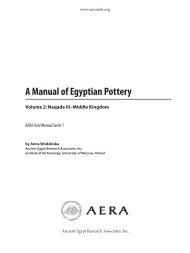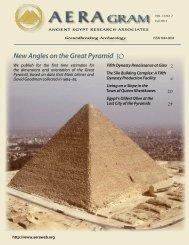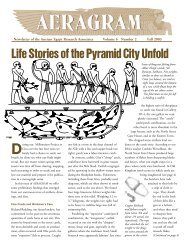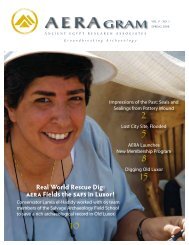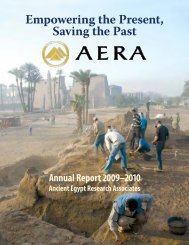The Khentkawes Town (KKT) - Ancient Egypt Research Associates
The Khentkawes Town (KKT) - Ancient Egypt Research Associates
The Khentkawes Town (KKT) - Ancient Egypt Research Associates
You also want an ePaper? Increase the reach of your titles
YUMPU automatically turns print PDFs into web optimized ePapers that Google loves.
www.aeraweb.org<br />
Modeling<br />
<strong>The</strong> custom-designed, portable Zoser Scanner (ZS), was<br />
equipped with four DEVELO Scanning Range Finders,<br />
four 1/2-inch CCD digital cameras (C mount), a gyroscope,<br />
a target for Leica TCRP 1205+ and a tablet PC.<br />
<strong>The</strong> gyroscope of the ZS measures its position, orientation,<br />
and velocity at the rate of 100 Hz (100 times per<br />
second). <strong>The</strong> four digital cameras accompanying each<br />
scanner took rapid sequence photographs of the pyramid<br />
fabric (fig. 5).<br />
<strong>The</strong> body of the ZS was automatically traced by the<br />
Leica TCRP 1205+ at the rate of 6-10 Hz, and the data was<br />
eventually synchronized by a GPS timer. <strong>The</strong> accuracy of<br />
the gyroscope depends on the number of satellites, and<br />
their orbits need to calibrate for at least half an hour after<br />
starting. Once it starts, the device should work with an<br />
uninterrupted power supply. If power is interrupted, the<br />
gyroscope needs to be re-calibrated. <strong>The</strong>refore, the ZS was<br />
connected to a long power cord during the survey to assure<br />
a continuous supply of electricity. <strong>The</strong> width of the<br />
ZS wings is 2.5 m each. This required that the climbers,<br />
Yamamoto and Sato, rappel each face about 25 times (the<br />
monument is 109.02 m north-south × 121 m east-west ×<br />
58.63 m high).<br />
<strong>The</strong> scanning of the whole pyramid with the ZS was<br />
theoretically supposed to be completed within 14 days, but<br />
some practical difficulties, such as slow descending speed<br />
due to deterioration of the stones and the requirement of<br />
an uninterrupted power supply, required us to modify the<br />
original plan. But overall, the entire coverage of the pyramid<br />
was completed with the Topcon GLS-1000 scanning at<br />
the rate of 5 mm mesh from 35 different positions. <strong>The</strong> top<br />
of the pyramid, the four corner ridges, and one area at the<br />
southern side of the southern bottom step remained the<br />
only “shadow” areas, not covered by our scanning. This<br />
data was integrated during post-processing.<br />
Rendering/Data Processing<br />
All the scanned data of GLS-1000 was integrated into<br />
a single point-cloud model on a computer at the headquarters<br />
of Topcon in Tokyo. Topcon’s original software,<br />
ScanMaster, generated point-cloud representations<br />
during post-processing. Color information from digital<br />
photographs taken by the built-in cameras on the<br />
scanner complemented 500 million points. We also used<br />
photos from a conventional hand-held digital camera to<br />
supplement color information.<br />
After this process, Tomii created a three-dimensional<br />
movie (1280 × 720 pixels, 30 ftp) and orthophotographs<br />
(3,000 pixels) of a plan and sections of the pyramid.<br />
However, due to the excessive quantity of data, it was not<br />
feasible to export 20,000 pixel orthophotographic images<br />
of the Step Pyramid with Pointools. So, Dr. Kosuke<br />
Sato and Dr. Ichiroh Kanaya developed a special program<br />
which can generate large size orthophotographic images<br />
from the point-cloud data.<br />
Results<br />
Our original aim was to create an image of the Step Pyramid<br />
as it really is rather than an interpreted line drawing. An<br />
extensive three-dimensional point-cloud model of the<br />
exterior of the pyramid was mainly produced by Topcon<br />
GLS-1000(s), but supplemented by the custom creation<br />
and implementation of the Zoser Scanner. We produced<br />
a plan, and four cardinal elevations of the pyramid, all of<br />
which can be printed out in a 1:100 size of the monument<br />
at 350 dpi (see Color Plates 7 and 8).<br />
70<br />
Giza Plateau Mapping Project Season 2008 Preliminary Report





